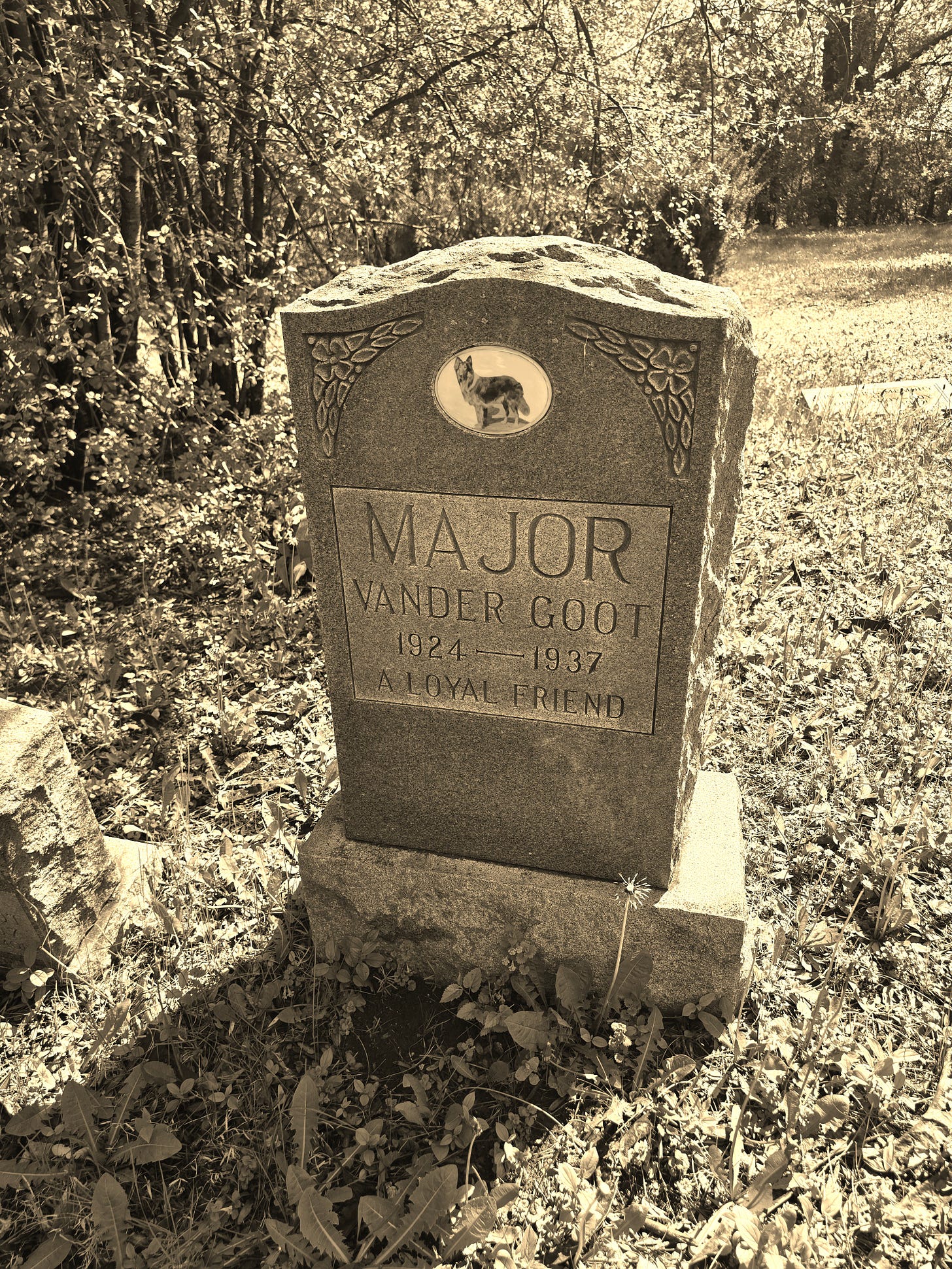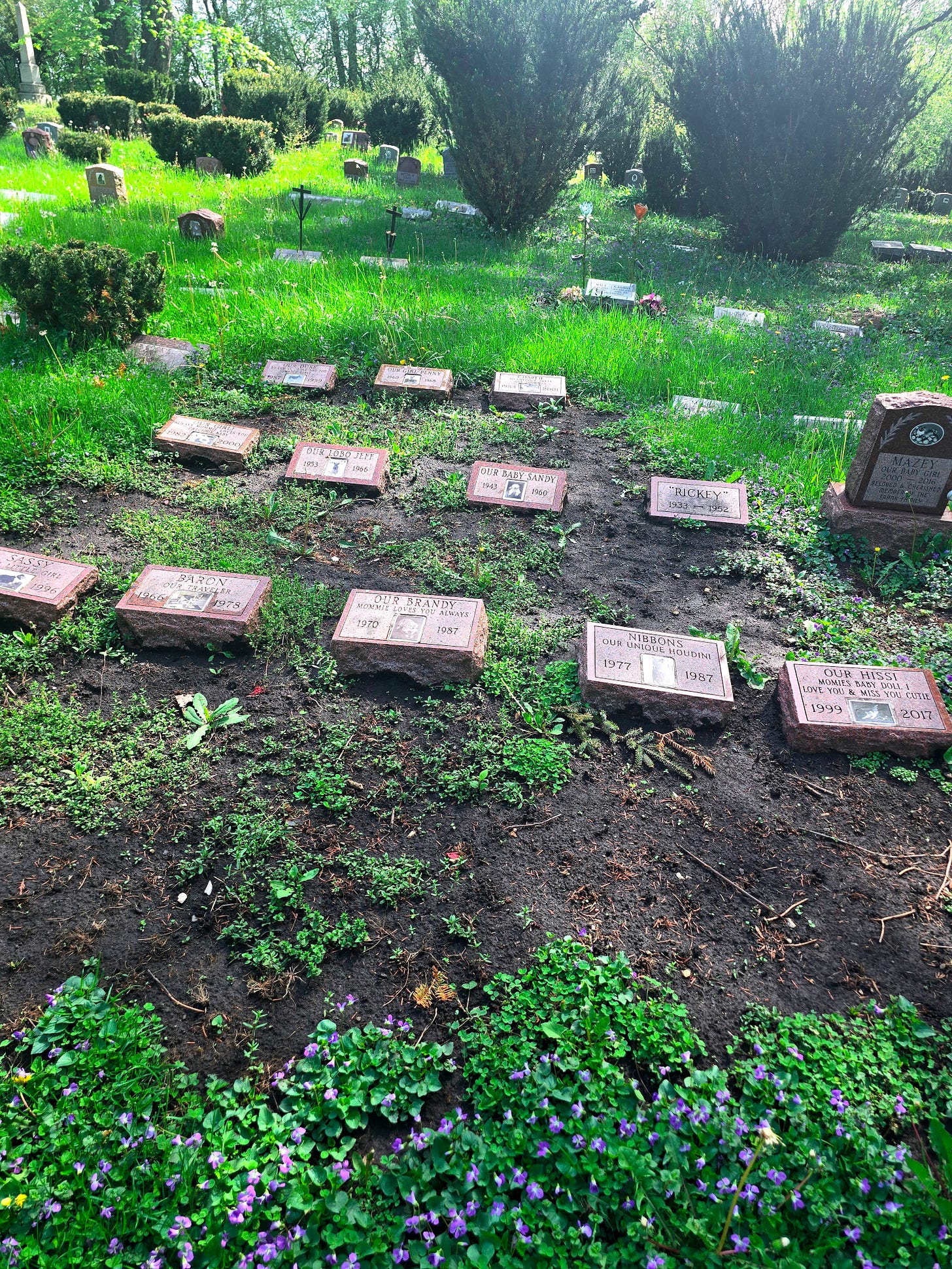Perhaps a macabre interest, I have always found pet cemeteries to be a kind of storybook—a testament to the enduring human-animal bond that spans generations. The graves, often weathered and overgrown, hold within them untold stories of the families who, decades ago, stood over the final resting places of their beloved companions, grief-stricken over their loss. For many of us, the deep affection for pets and the modern rituals surrounding their death might seem like a recent development—something unique to our time, perhaps only becoming significant in the last century. However, this assumption could not be further from the truth.
On a recent excursion, I found myself once again wandering the grounds of a pet cemetery that I had long passed by, but had never taken the time to explore. The atmosphere was one of quiet reverence, broken only by the occasional distant hum of passing cars. The cemetery sprawled across acres of hilly landscape, dotted with tombs, headstones, and markers of various shapes and sizes, each one bearing the names of pets and the loving tributes of those who had mourned them. The site was rich with trees—oaks, elms, willows, and maples—offering shade and tranquility. Many of the trees, I imagined, had grown long after the pets they commemorated had been laid to rest. The lush green grass was overtaking much of the cemetery, and in some areas, gravestones had fallen into disrepair or were nearly swallowed by the encroaching vegetation. Still, the air was heavy with the weight of memory.
As I wandered, reading the inscriptions on the markers, I was struck by the enduring nature of the sentimentality and grief that humans have long felt for their pets. The words engraved on the stones were often poignant and deeply personal: "In loving memory of a faithful friend," "Forever in our hearts," "The best companion, now at peace." Some stones bore simple epitaphs, while others were adorned with elaborate engravings and colorful photographs of the pets in happier days. The presence of these images, often sepia-toned or faded, added a humanizing element to the otherwise silent stones. Each photograph told a story, immortalizing the pet in the eyes of the family who had lost them.
One of the most striking aspects of the cemetery was how old some of the gravestones were. I saw dates stretching back to the early 20th century, and even to the late 19th century in some cases. A reminder that our relationship with animals as companions and family members has a much longer history than many might assume. It was also remarkable to note how many of the pets buried there had lived short lives, some having passed away before reaching even a year of age. The grief expressed by their families seemed to defy the brevity of the lives they had shared with their animals. The love and attachment, however brief the time, were evident in the care taken to memorialize these pets.
The economic hardship of earlier decades added another layer of poignancy to the experience. During times such as the Great Depression, when money was tight and families were struggling to make ends meet, the fact that people still chose to spend what little they had on formal burials for their pets speaks to the depth of the human-animal connection. It is clear that, despite financial hardship, people were willing to make significant sacrifices to honor their pets. This act of devotion is perhaps more striking in the context of the times, highlighting the lengths to which people would go to express their love for their companions, even when survival was uncertain.

Historically, the burial of pets has a much longer tradition than one might think. Ancient civilizations, from the Egyptians to the Greeks and Romans, practiced rituals to commemorate the death of beloved animals. In ancient Egypt, for instance, cats, which were regarded as sacred animals, were often mummified and buried with their owners, a practice designed to ensure a lasting bond in the afterlife. Similarly, in ancient Rome, pets were sometimes buried with markers and inscriptions, much like human graves, attesting to the importance placed on the bond between humans and animals. In more recent centuries, as urbanization grew and the relationship between humans and animals evolved, formal pet cemeteries became more commonplace. By the late 19th and early 20th centuries, pet cemeteries were established in major cities around the world, offering pet owners a dignified place to mourn and memorialize their companions. These burials often followed similar rituals to those for human remains, with headstones, epitaphs, and even religious ceremonies marking the passing of a pet.
As part of my research for this particular post, I attempted to contact several individuals whose names appeared on the pet markers, hoping to learn more about the stories behind the inscriptions and the love they most certainly shared. Unfortunately, my efforts were largely unsuccessful, many of the owners having long passed ago. However, I did manage to trace the previous owner of the dog marked “Jack,” whose grave was among those I had been admiring. The owner, a well-known and successful local business owner who had passed away many years ago. Through conversations, I learned that he had always been particularly fond of dogs. Those who remembered him spoke fondly of his deep affection for his pets, describing how he treated them like family. His bond with Jack, in particular, seemed to have been especially profound. Even in death, the memory of the bond between owner and pet persisted. This brief connection served as a poignant reminder of how deeply the loss of a pet can impact its owner, leaving a lasting imprint that, much like the headstones in the cemetery, outlives both the pet and the person.
Pet cemeteries, in their many forms, provide a unique window into the ways in which humans have ritualized and memorialized the lives of their pets throughout history. What strikes me most about these places is the overwhelming sense of love and care that continues to echo from the grave markers. Despite the passing of time, the bond between humans and animals remains a universal and enduring aspect of our shared experience. The pet cemetery, often overlooked or dismissed as a morbid curiosity, serves as a profound reminder of the lasting connection between humans and their animal companions—a connection that has spanned centuries and continues to shape our lives today. In reflecting on the burials and the words etched in stone, I am reminded that the love we have for our pets is neither a recent phenomenon nor a fleeting emotion. It is, rather, an integral part of our shared humanity.










Wonderful article! I was just in London and there is a hidden pet cemetery in Hyde Park. It's unfortunately closed to the public but you see if you peek through the gate. It was active from 1881-1903.